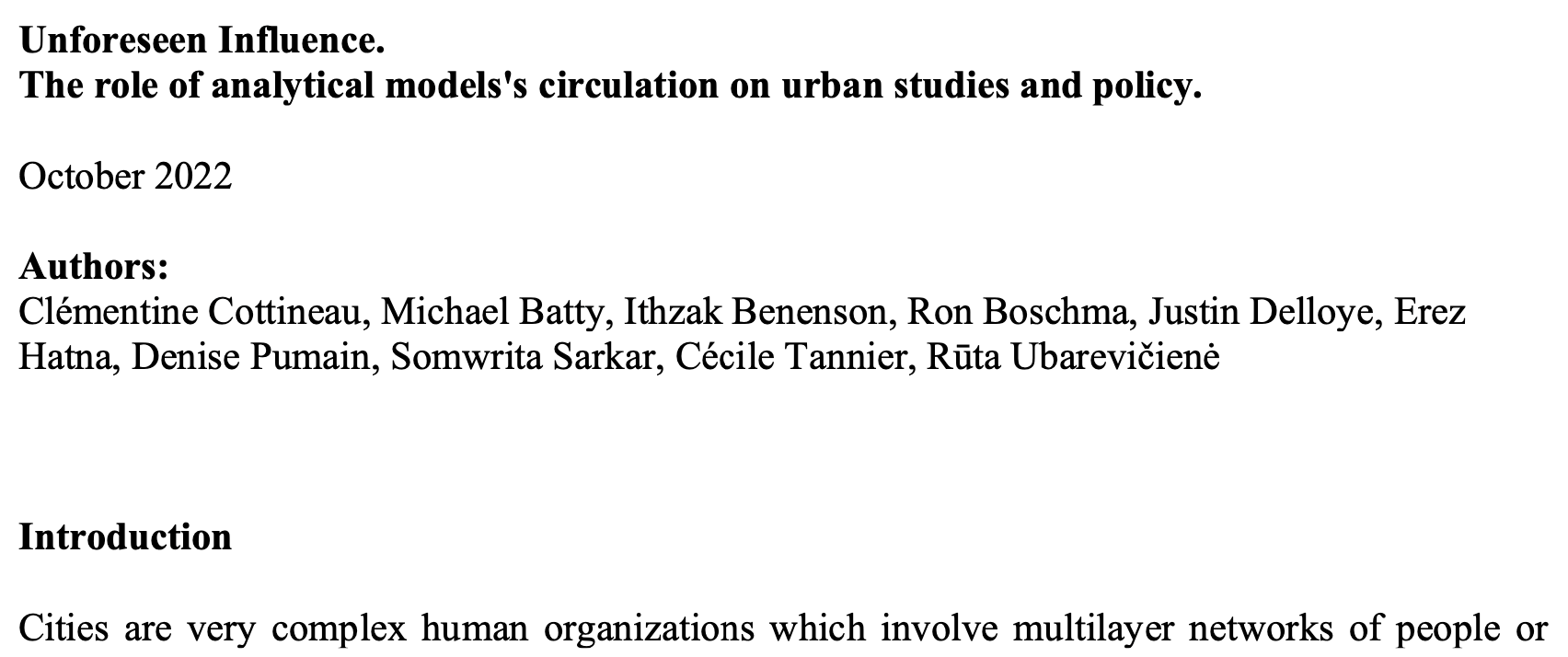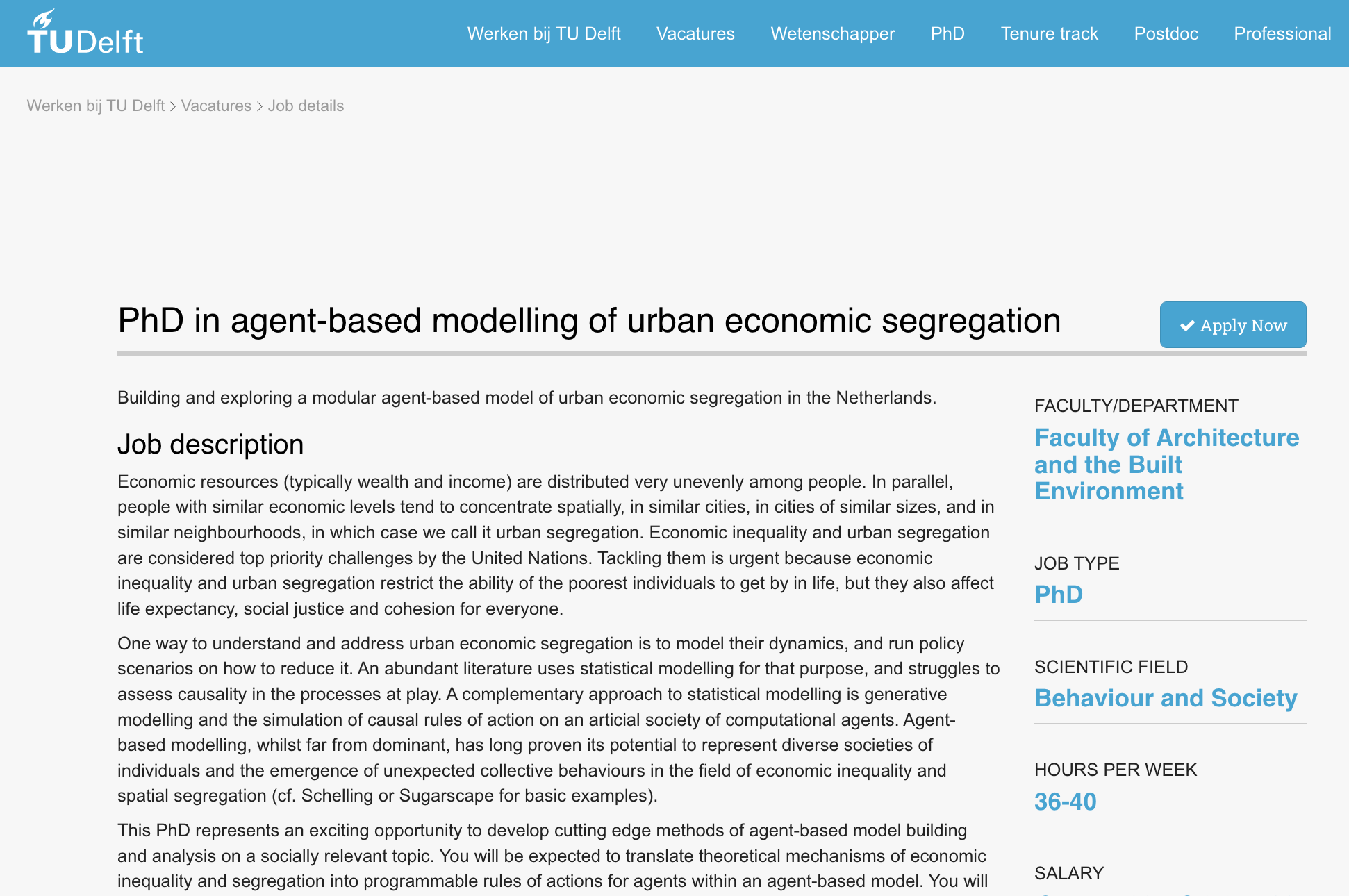Analytical urban models circulation: towards reusable building blocks
Clémentine Cottineau
Assistant Professor of Urban Studies
c.cottineau@tudelft.nl

LISER Research Seminar, 25 October 22
Urban models
To help understand, visualise, analyse and plan future cities
Simplifications of urban reality, representation of social processes
Middle ground between general and particular
Useful for comparison and hybridation
>> Prone to circulation
Types of models
- theoretical ideas about what cities are and how they function
- normative practices about how we should plan and build cities
- analytical representations to study and simulate the structure and evolution of cities
Urban model circulation
- theoretical ideas about what cities are and how they function
>>> Knowledge on knowledge literature
- normative practices about how we should plan and build cities
>>> Policy transfer and Policy mobilities literature
- analytical representations to study and simulate the structure and evolution of cities
>>> Do they circulate like urban policies?
Research questions
1. What is the importance of contingent elements of context on the design and circulation of analytical urban models?
2. What are the (unforeseen) consequences of urban models' im/mobility on our understanding of cities?
3. What happens to analytical urban models and their reception during their circulation across geographical and disciplinary boundaries?
Literature
Policy Transfer (political science)
> e.g. Dolowitz & March, 2000
- Typically international
- Fixed policy before/after
- Factors of success/failure
- Transfer type
Policy Mobilities (geography)
> e.g. Theodore & Peck, 2010
- Typically inter-city / global-local
- Policy as assemblages changing during circulation
- Focus on actors of circulation
- Mobility / immobility / return, etc.
Relevance for analytical urban models
1. Because urban models circulation reflects the embeddedness of actors in power relations rather than rational choice
-
Difference in resources, capital, influence and legitimacy to spread the model and convince various audiences
-
Inertia of "classic" model becoming "off-the-shelf" solutions
Relevance for analytical urban models
2. Because representations of cities are situated and linked to particular contexts and individual agents of circulation
-
Influence of particular context on model content
-
Ethnographic methods of following to understand them
Relevance for analytical urban models
3. Because models of cities, just like urban policies, are assemblages which change in content and interpretation as they circulation
-
Socio-materiality of urban models (what they are made of)
-
Path-dependency of what circulates and how it is remembered
Data & Methods
Reflexive method to follow analytical models' circulation:
-
Choose 8 classical models
-
Define 4 comparative categories of analysis
-
Invite scholars related to the models to present their circulation according to the comparative categories of analysis
-
Set up seminar series and legacy (recorded videos + edited podcast) to collect information (data)
-
Analyse and compare models in scientific article
Seminar schedule

Selecting "data"
Criteria for choose models and presenters:
-
Models should reflect the diversity of urban modelling
-
Models should reflect the diversity of modelling formalisms
-
Models should be "classics", i.e. having circulated widely
-
Presenters should have diverse sources of academic legitimacy (having created the model, reviewed it, developed it or taught it)
Selected models

Selecting "categories"
In line with following and situation analysis methods (McCann & Ward, 2012), the categories chosen are:
-
The model (aim, goal, components, mechanisms)
-
The biography (of creator, model circulation in geographical and academic space)
-
Influence on urban studies (through replication, development, adaptation, ideas, critique)
-
Influence on urban policy (through application to existing cities)
Seminar legacy



Podcast
Videos
Manuscript in writing...
Results
Comparative results:
-
along 4 categories of analysis (model, biography, urban studies, policy)
-
with a particular focus on 2 models for each category
1. The Models
| Models | Issue/aim | Actors/Features | Main finding |
|---|---|---|---|
| CPT | explain size, number and spatial distribution of cities | population, demand/ supply, transports | few principles lead to regular nested hexagons |
| Alonso | Formalise urban centrality | households, landlords, jobs, transports, houses | trade-off in consumption explains density decrease |
| Economic Base Theory | explain local economic development | industries, production, cities, income flow | local development through exports |
| Fractals | new geometry for irregular objects | shapes, land use, dimensions | fractals to understand multi scale organisation of space |
| EEG | spatialise evolutionary eco | industries, relatedness | relatedness > diversity |
| Schelling | unintentional segregation | agents, cells, tolerance | segregation with tolerance |
| Forrester | positive and negative feedback in cities | population, jobs, stocks, flows | logistic growth of cities because capacitateed |
| Utilitarian models | measure "happiness" and maximise it collectively | individual, collective cost, benefit | maximising total utility does not achieve collective utility |
1. Focus
-
Monocentric city model. Deductive presentation of models' assumptions by J. Delloye. Crucial to understand that function centrality is assumed, morphological is derived in Alonso's model.
-
Fractals. Presentation by C. Tannier of self similarity, fractal objects and dimensions, then how fractal generators can simulate urban-like morphologies.
Heterogeneous nature and materiality of models:
> monocentric model as unique/formal source (Alonso's 1964 book)
> factal models as "assemblages" (ideas, measurement protocols, etc.)
2. The Biographies
| Models | Creation context | Reception | Circulation |
|---|---|---|---|
| CPT | Christaller's thesis 1932 | critical in 1930s Germany because too theoretical | through IGU, quant turn & English translation (66) |
| Alonso | Alonso's thesis 1964 | Muth (1969), Mills (1970) | New Urban Economics |
| Economic Base Theory | Early 20th century. Hoyt or Sombart? | Positive, with challenge from input-output model | continuous additions and empirical tests |
| Fractals | Mandelbrot, 1980s | aesthetic fascination | from maths to everywhere |
| EEG | Martin, Boschma & Frenken, 1990-2000 | in regional science and complexity economics | very rapidly from academia to european policy agenda |
| Schelling | Sakoda 1949 / Schelling 1970 | turn of fate for the models | Through Schelling's reputation as strategist |
| Forrester | 1971 book, MIT | "out of the blue" | Club of Rome + reputation |
| Utilitarian models | Bentham, 1789 | ? | Wide diffusion. Ex. Cost-benefit analysis |
2. Focus
-
Central Place Theory. Influence of WWII and Christaller's political affiliations on model reception, but also momentum from quantitative geography and translation into English.
-
Urban dynamics. Importance of Forrester's academic position at MIT (after working on computer projects for the military), and later Club of Rome. Isolated in urban modelling but fresh approach from electrical engineering and problem oriented > new approach
Heterogeneous source of modelling choices and circulation:
> engineering aspect of Urban Dynamics because of Forrester's educ.
> graphical elegance to convince regional planners with opposite goals
3. Influence urban studies
| Models | Relays | Evolution | Transfer/diffusion/mobility |
|---|---|---|---|
| Christaller | Regional science pioneers + Baskin | from regional planning to baseline & networks | Mobility |
| Alonso | New Urban Economics | from housing market (eco) to density profile (geo) | Diffusion / Transfer |
| Economic Base Theory | Isard, Tiebout, Davezies | From export oriented to residential development | Mobility |
| Fractals | Frankhauser, Batty | description to generation | Transfer/Diffusion/mobility |
| EEG | Hidalgo/Hausmann | from local to relational capabilities | Mobility |
| Schelling | Benenson&Hatna | abstract to empirical city | Mobility |
| Forrester | LUTI modellers | application to dynamics | Transfer |
| Utilitarian models | Multiple | from positive to normative analysis | Diffusion |
3. Influence urban studies
-
Economic Base Theory. Story of a model with unknown origin but history of adoptions/adaptations by multiple authors. Even to the point where model adapted to reach opposite conclusions
-
Schelling. Simple model for simple result. Many adaptations show that qualitative behaviour of the model is very robust.
Opportunity of model influence in urban studies:
> memorable qualitative result mark how urban scholars think about cities
> versatile tool to analyse scenarios quantitatively.
4. Influence urban policy
| Models | Urban policy use | Applications | Recognition |
|---|---|---|---|
| Christaller | plan location + size of urban centres | Dutch polders, Israel, China | Implicit |
| Alonso | effect of commuting costs on sprawl | LUTI models | Implicit |
| Economic Base Theory | Design export support policy or infrastructure investment | Multiplier effect of export investment on employment | ? |
| Fractals | Settlement development plan design | Besançon | explicit |
| EEG | Diversity economic specialisation | EU | Implicit |
| Schelling | Housing policy | Singapore | Implicit |
| Forrester | avoid resource over-expoloitation | ? | ? |
| Utilitarian models | Optimise cost-benefit performance | Most planning project evaluation | varies |
4. Influence urban policy
-
Evolutionary Economic Geography. Used by EU regional planning to support related industry development. Helps decision on development direction (towards more complex related industries)
-
Utilitarian models. Used to maximise total (aggregated) utility, but through suboptimal collective equilibrium. Need for distributional considerations.
Recognition usually implicit, through long chain of influence and appropriation by urban scholars, consultants, advisors and policy makers. Long and tortuous feedback from applications to model evaluation.
Discussion
Contingent factors of model success:
-
Creator's language & translation hurdles (partial-incomplete & partial-ideological)
-
Geographical inequality in circulation power (access to time, budget, media, translation, cultural capital etc.)
-
Disciplinary origin and corresponding legitimacy + audience
-
Gender power imbalance in academia
-
Institutional labelling (policy mobility) > Path dependency (analytical urban models)
Discussion
Essential factors of model success:
-
Model's simplicity & clearly defined issue
-
Transparency of key hypothesis
-
Transportability of model (i.e. relevance and applicability to other case studies, sites, issues & disciplines)
-
Formal presentation (graphical, mathematical) can work both ways.
Conclusion
Analytical urban models' content and circulation is contingent on their creation and reception context. Need to travel with their metadata!
Need to question contingent elements and path-dependency influence in model circulation to keep essential components and adapt them to new uses
Metadata and context information = crucial to keep models and model results meaningful and useful as building blocks.
Perspectives
Reusable Building Blocks for inequality and segregation modelling.
> New ERC starting grant grant: SEGUE / 2022-2027
Combining theories and models from economics, sociology and geography to explain linked evolution of economic inequality urban segregation.
-
analyse model components, actors, scales, main finding
-
combine them into modular infrastructure
-
initialise on synthetic population using exhaustive individual register data from NL
-
simulate multiple mechanisms of inequality and segregation
-
evaluate model against empirical data
-
provide multiscale scenarios of urban economic segregation reduction

Recruitment in progress!
Analytical urban models circulation & economic segregation
Clémentine Cottineau
@clementinecttn / @urbanmodseminar
c.cottineau@tudelft.nl

https://slides.com/clementinecottineau/an-evolution-of-analytical-urban-models-and-geosimulation-dbc0e0
Thank you!
Analytical urban models circulation, towards RBB
By Clémentine Cottineau
Analytical urban models circulation, towards RBB
- 676



